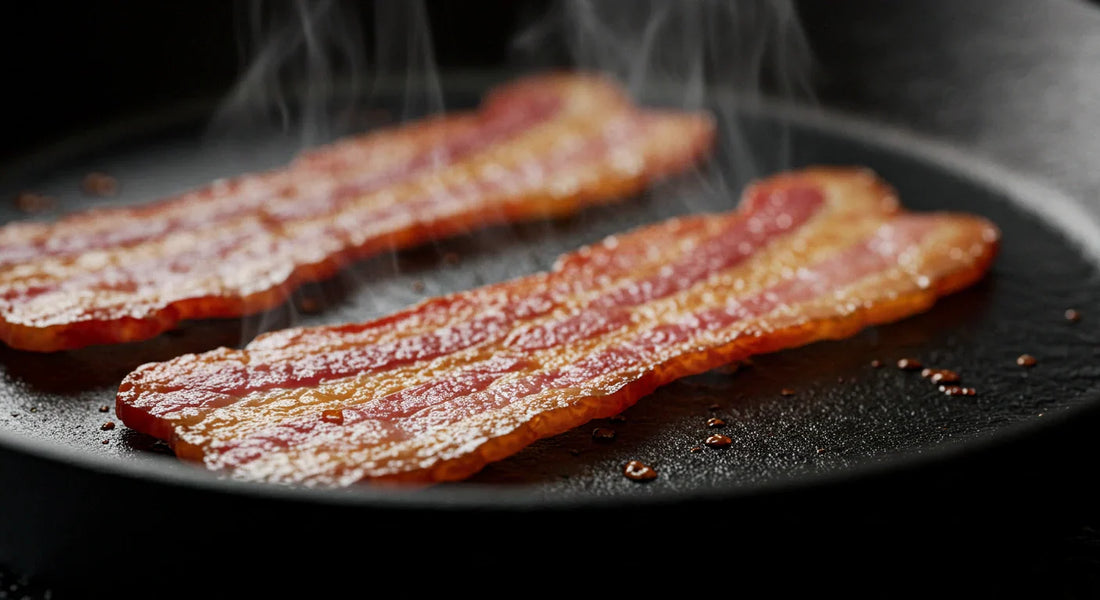
Buying Bacon: Recognizing Differences in Quality and Processing
Teilen
In the world of culinary delights, few foods inspire the same level of devotion as bacon. That distinctive sizzle in the pan, the mouthwatering aroma that fills your kitchen, and the incomparable flavor that enhances everything it touches—bacon isn't just food; it's an experience. But when you're standing in the grocery store faced with dozens of options, how do you decide which bacon to buy?
Whether you're looking to buy bacon for everyday cooking, searching for premium organic bacon, or specifically wanting to buy fatty bacon for special recipes, understanding quality differences is essential. This comprehensive guide will help you navigate the bacon aisle with confidence and ensure your breakfast, BLTs, and bacon-wrapped delicacies always shine.
Understanding Bacon Basics
Before you buy bacon, it's worth understanding what you're actually purchasing. Bacon comes from different parts of the pig, each offering unique characteristics that affect both flavor and cooking properties.
The most common type in North America is side bacon (also called streaky bacon), which comes from pork belly. This cut delivers those beautiful strips with alternating layers of fat and meat that crisp up perfectly when cooked. When you buy bacon of this variety, you're getting a product that works well in nearly any application.
Back bacon (popular in the UK and Canada) comes from the loin and contains more meat with less fat. Meanwhile, jowl bacon comes from the cheeks and offers a distinctively rich flavor with plenty of fat marbling. For specialty dishes, you might even buy bacon made from the shoulder (known as cottage bacon).
The curing process fundamentally defines bacon. Traditional dry curing involves rubbing the pork with a mixture of salt, sugar, and spices, then allowing it to cure for days or weeks. This method concentrates flavor and draws out moisture naturally. When you buy bacon that's been dry-cured, you're typically getting a premium product with deeper flavor and better texture.
Wet curing (or brining), the more commercial approach, injects the meat with a salt solution, significantly speeding up the process. While more economical, wet-cured bacon often shrinks more during cooking and can have a watery quality when it hits the pan. Budget options typically use this method, which is why quality can vary dramatically when you buy bacon at different price points.
Smoking adds the final distinctive touch to bacon. Different woods impart different flavors—hickory provides a strong, traditional bacon flavor, while applewood offers a sweeter, milder profile. Some artisanal producers use cherry, maple, or even mesquite. When you buy bacon from specialty producers, these smoking details are often highlighted on the packaging as selling points.

Identifying Quality Bacon
When you set out to buy bacon, visual assessment is your first quality indicator. Premium bacon displays a good balance between fat and lean meat—typically about 50/50 in traditional belly bacon. The fat should be white or slightly cream-colored, never yellow or gray, which indicates age or poor quality. The meat portion should appear pink or red, looking fresh rather than brown or dull.
Thickness matters significantly depending on your intended use. When you buy bacon for different cooking applications, consider that:
- Thin-sliced bacon (standard supermarket variety) cooks quickly and crisps easily, ideal for breakfast strips or crumbling into salads
- Medium-sliced offers versatility for most applications
- Thick-cut bacon (often labeled "butcher's cut") provides substantial texture and won't shrink as dramatically, making it perfect for bacon-focused dishes like BLTs or for adding to soups
When reading labels as you buy bacon, ingredient simplicity indicates quality. Premium bacon contains minimal ingredients—typically pork, salt, sugar, and spices. Be wary of products containing sodium phosphates, sodium erythorbate, sodium ascorbate, or nitrates/nitrites in high amounts. While some preservatives are traditional in curing, an excessive chemical list suggests a heavily processed product.
Don't be fooled by packaging claims like "natural" or "uncured." Technically, all bacon is cured by definition. "Uncured" bacon typically uses celery powder or juice (naturally high in nitrates) rather than synthetic preservatives, but the curing process still occurs. When you buy bacon marketed as "natural," look beyond the front label to the actual ingredients list for the complete story.
Mass-produced bacon prioritizes consistency and affordability, while artisanal bacon emphasizes flavor complexity and traditional methods. The price difference when you buy bacon from specialty producers reflects not just marketing but genuine differences in production methods, ingredient quality, and curing time.
Exploring Organic Bacon Options

When you decide to buy organic bacon, you're selecting a product that meets specific production standards. Authentic organic bacon comes from pigs raised without antibiotics or growth hormones, fed 100% organic feed, and given access to the outdoors. This typically results in a product with fewer chemical additives and preservatives.
To ensure you truly buy organic bacon that meets these standards, look for certification from the USDA Organic program or other recognized organic certification bodies. These certifications verify that the product meets strict guidelines throughout the production process.
Many consumers who buy organic bacon report a cleaner, more pronounced pork flavor compared to conventional alternatives. This difference stems partly from the pigs' diet and living conditions, which can influence the fat composition and overall taste profile of the meat.
Animal welfare considerations also motivate many consumers to buy organic bacon. Organic standards typically require more humane raising practices than conventional production methods, including access to pasture and prohibition of confinement systems.
Is it worth paying more to buy organic bacon? The answer depends on your priorities. If you value minimal processing, stricter production standards, and potentially better flavor, the premium price may be justified. For special occasions or when bacon is the star of your dish, many culinary enthusiasts specifically buy organic bacon for its superior taste characteristics.
The Case for Fatty Bacon

While some shoppers shy away from fat content, those in the know specifically seek to buy fatty bacon for certain applications. The fat in bacon isn't just filler—it's a flavor carrier and cooking medium that delivers much of bacon's magic.
When you buy fatty bacon, you're getting a product that self-bastes during cooking. The rendered fat helps cook the meat portion evenly while developing that coveted crispy exterior. Leaner bacon can become dry or tough without careful cooking, while fatty cuts offer more forgiveness and typically yield better texture.
Certain recipes specifically benefit when you buy fatty bacon:
- Wrapping lean meats like chicken breasts or filet mignon
- Adding to beans, greens, or stews where the rendered fat seasons the entire dish
- Creating lardons for salads or pasta, where the rendered cubes of fatty bacon add richness
- Making bacon jam or bacon-infused dishes where the fat carries and distributes flavor
The fat rendering process is actually an advantage when you buy fatty bacon. The rendered fat becomes liquid gold in the kitchen—store it in a heat-safe container in your refrigerator to use for frying eggs, sautéing vegetables, or making the world's best grilled cheese sandwiches.
For those concerned about health aspects when they buy fatty bacon, consider that bacon is typically consumed in moderation as a flavoring component rather than a main protein source. Using smaller amounts of more flavorful, fatty bacon often provides better culinary results than larger amounts of leaner varieties.
Making Your Selection: Tips for Bacon Buyers
When you're ready to buy bacon, consider these practical tips:
- Buy from trusted sources: Specialty butchers, farmers' markets, and high-end grocers typically offer superior options compared to discount stores.
- Check the best-by date: Fresh bacon has a relatively short shelf life. Buy bacon with the furthest date possible for maximum quality.
- Examine packaging integrity: Avoid packages with excess liquid, which indicates poor quality or temperature fluctuations.
- Consider your cooking method: Different bacon types suit different applications. Buy fatty bacon for wrapping meats, leaner bacon for dishes where you don't want excess grease.
- Try different varieties: Experiment with various brands and styles. You might discover you prefer to buy organic bacon for some dishes but conventional for others.
- Store properly: Once you buy bacon, store unopened packages in the refrigerator for up to two weeks, or freeze for up to six months. Opened bacon should be tightly wrapped and used within a week.
- Cook from room temperature: For about 15 minutes before cooking, let your bacon sit at room temperature for more even rendering.
Conclusion
The quest to buy bacon that meets your quality standards doesn't have to be overwhelming. Whether you choose to buy organic bacon for its production values, buy fatty bacon for specific culinary applications, or simply want to upgrade your breakfast game, understanding these quality distinctions empowers you to make informed choices.
Remember that bacon, like many traditional foods, reflects the care taken in its production. While budget options have their place, investing occasionally in premium bacon can transform ordinary dishes into memorable meals. The next time you set out to buy bacon, take a moment to consider what qualities matter most to you—flavor complexity, ethical production, fat content, or versatility—and select accordingly.
With this knowledge in hand, you're well-equipped to navigate the bacon aisle with confidence, appreciating the craft behind this beloved food and selecting the perfect variety for your culinary creations.

